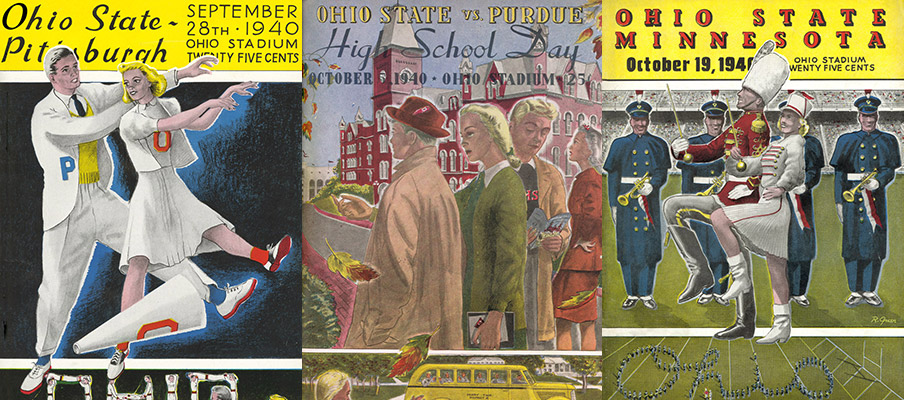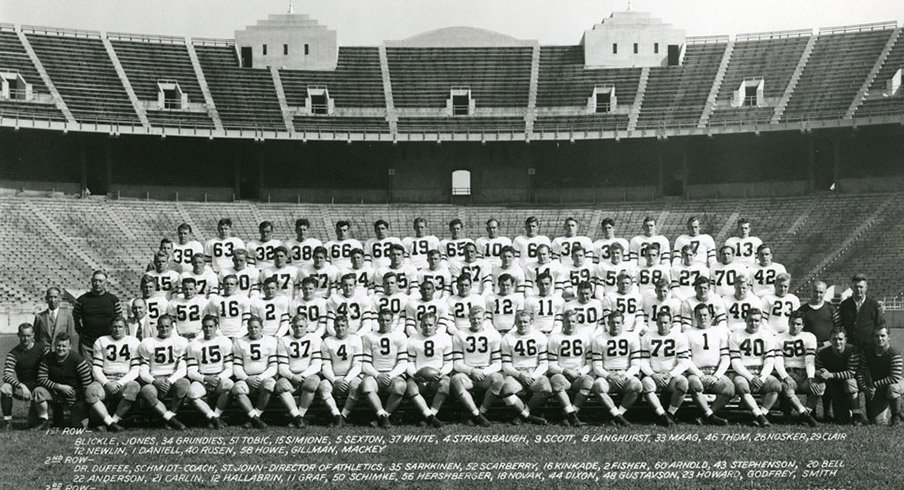Losses were mounting on the field, and tensions were rising in the locker room, as Francis Schmidt prepared for the 1940 season. By all accounts, this was his make or break campaign.
Francis Schmidt was a respectable 35–12–1 in his first six seasons as head coach of the Ohio State Buckeyes. He had arrived with a bang, going 14–2 in his first two seasons, beat Michigan in his first four tries – shutout Michigan in each of those four games – and was the driving force behind several traditions Buckeye fans cherish today, like the Gold Pants awarded to players.
However, by 1940, the tall Texan had lost favor with his players, some fans and some elements within the university. Schmidt needed wins on and off the field if he was to remain the head coach in Columbus.
| The 1940 Buckeyes | |
|---|---|
| Record | 4–4 |
| B1G Record | 3–3, 4th |
| Coach | Francis Schmidt (7th year, 39–16–1) |
| Captains | Jim Langhurst |
Games of Note
September 28 • Pittsburgh • Ohio Stadium
It was unusually hot for Ohio State's opener and the Buckeyes started the game slowly. Neither team could manage to put points on the board until Charlie Maag's foot gave the Buckeyes a 3-0 lead right before halftime.
This wasn't a very good Pitt team, however. Ohio State put up three touchdowns in the third quarter on the way to scoring the game's final 27 points for a 30-7 win.
This was Ohio State's first win over Pittsburgh in 10 years and tied the series at 2–2–1.
October 5th • Purdue • Ohio Stadium
Unlike the week before, Ohio State started fast against Purdue. Touchdown runs by Dick Fisher and Jim Langhurst gave the Buckeyes a first half lead of 14-0. That lead wasn't bullet proof, though.
The Boilermakers scored twice in the second half to tie the game at 14. Purdue was pushing for its second straight win over the Buckeyes, but Maag's leg wouldn't let that happen.
With 19 seconds remaining, Ohio State was in position to win the game. The Buckeyes faced fourth down on Purdue's 12-yard line. Maag's kick was true and the Buckeyes had their second victory of the season in the books. At least that's how it went into the books.
| DATE | OPPONENT | LOCATION | RESULT |
|---|---|---|---|
| SEP. 28 | PITTSBURGH | OHIO STADIUM | W, 30–7 |
| OCT. 5 | PURDUE | OHIO STADIUM | W, 17–14 |
| OCT. 12 | NORTHWESTERN | DYCHE STADIUM | L, 3–6 |
| OCT. 19 | NO. 7 MINNESOTA | OHIO STADIUM | L, 7–13 |
| OCT. 26 | NO. 1 CORNELL | SCHOELLKOPF FIELD | L, 7–21 |
| NOV. 2 | INDIANA | OHIO STADIUM | W, 21–6 |
| NOV. 16 | ILLINOIS | MEMORIAL STADIUM | W, 14–6 |
| NOV. 23 | MICHIGAN | OHIO STADIUM | L, 0–40 |
| 4–4, 99–113 |
Woody Holmes, a reporter from Chillicothe, reviewed the play-by-play a few days after the game and found that Maag had left the game in the early part of the second quarter only to return before halftime.
Again this was a different era, with substitution rules and players were prevented from reentering the game in the same quarter in which they left. If the referee had thrown the flag for illegal substitution, Ohio State would have lost 15 yards and Maag would have been suspended for the remainder of the game.
No Maag, no winning kick.
When Schmidt was told of the error he owned it and was remorseful for the mistake. It is believed that Purdue was contacted by Ohio State and the Buckeyes offered to forfeit the game, or at the least, have Maag's field goal disallowed. The Boilermakers did not accept the offer as the score still states 17-14 in both team's official standings.
October 26th • No. 1 Cornell • Schoellkopf Field
The Buckeyes provided the backdrop for Cornell's biggest home game...ever.
Leading up to this game, Ohio State had lost two heartbreaking games to Northwestern and Minnesota. The Wildcats scored a late touchdown to win 6-3. The Gophers escaped with a 13-7 win after the Buckeyes were unable to produce points after four drives deep in Minnesota territory.
Even though Ohio State came in with a 2–2 record, the excitement around Ithaca was palpable.
The Big Red were undefeated and the No. 1 ranked team in the country. Beating Ohio State would be national news and everyone in the area wanted to witness the historical event. Cornell had to add temporary bleachers and increase its seating capacity to 34,000 to appease the masses.
A little gamesmanship was exhibited by Schmidt and the Buckeyes when the team arrived with only their white uniforms. In 1940, the home team decided what color uniform it would wear. Cornell always wore white uniforms at home and Ohio State arriving with its away color forced the Big Red to wear red.
Game on.
The Buckeyes took their opening drive 89 yards and scored the contest's first touchdown. From there it was all Cornell. The Big Red defense did not allow Ohio State into the red zone the rest of the game and recorded five interceptions on the way to a 21-7 victory.
The decision to wear white uniforms backfired for the Buckeyes. To this day Cornell wears red uniforms at home because the 1940 team voted to wear the color at home from that point forward. Ohio State's choice of attire wasn't the only controversy for the Big Red that season.
Cornell carried an 18-game unbeaten streak and the No. 1 ranking into a late season game against Dartmouth. The conditions for the tilt were horrible and the field kept both teams scoreless going into the fourth quarter. Dartmouth finally kicked a field goal to take a 3-0 lead late in the game. Cornell had one last chance for a perfect season and national championship.
From The Ithaca Times:
Cornell managed to get to the Dartmouth 1-yard line with 6 seconds left. Cornell called an illegal time out, there was a penalty, but in the end a completed touchdown pass and Cornell squeaked by with a 7-3 victory, or so it seemed. In the confusion of those final seconds, it turned out that Cornell had scored on a fifth down. Still, the game was over and the referees gone, so the result would have to stand.
Except it didn’t. After reviewing the game films, and receiving a confirming telegram from referee Red Friesell, university president Ezra Day told the team on Monday that he had sent the president of Dartmouth a telegram offering to concede the victory to Dartmouth. He also told them that he was quite certain Dartmouth would refuse the offer. Dartmouth promptly accepted the forfeit and the score was changed to a 3-0 Dartmouth victory.
That's something.
November 16th • Illinois • Memorial Stadium
Only 15,571 Illini fans showed up to watch Ohio State win its sixth straight game in the series.
| OPPONENT | STREAK | RECORD |
|---|---|---|
| PITTSBURGH | W1 | 3–2–1 |
| PURDUE | W | 7–1 |
| NORTHWESTERN | L1 | 12–6–1 |
| MINNESOTA | L1 | 2–3 |
| CORNELL | L2 | 0–2 |
| INDIANA | W2 | 14–8–3 |
| ILLINOIS | W6 | 15-12-2 |
| MICHIGAN | L3 | 10–25–2 |
Don Scott was responsible for the Buckeyes' 14 points in windy and icy conditions, rushing for both touchdowns and making both conversion kicks. The defense held Illinois to six points and intercepted four passes.
The win would be the last for Schmidt as Ohio State's head coach.
November 23rd • Michigan • Ohio Stadium
Ohio State entered the game with a 4–3 record and was looking to end its losing streak to the Wolverines. On a foggy and rainy day, 73,648 fans were in attendance to cheer on the Buckeyes.
From the start, there wasn't much to celebrate on the home side of the field. Ohio State lost 40-0, and Michigan's Tom Harmon took advantage of Buckeye players who were uninspired and disinterested.
Harmon had an impressive stat line. On offense, he was responsible for five of the Wolverines' six touchdowns. The Michigan captain passed for 151 yards and rushed for 139 yards. He also showed skill on special teams by kicking four extra points, gaining 81 yards on punt returns and averaging 50-yards per punt.
When Harmon – the 1940 Heisman Trophy winner – left the field for the final time the Ohio State fans cheered and applauded him for his performance.
Ohio State's dismal performance as described by The Cleveland Plain Dealer:
Ohio State today crashed to the lowest depths of its modern football history.
[...]
It was the worst loss Ohio State has experienced since it entered the Big Ten in 1913 -- its worst loss since it became recognized as a major football team.
[...]
In the way in which today's disaster occurred, it easily can be classed as Ohio's most startling and thorough rout of all time. There were bigger scores run up on Ohio in the old, old days, but no Buckeye team ever looked worse or seemed to have less zest for battle.
Footage from Harmon's big day in the Shoe:
After losing three consecutive games, Ohio State was now 10–25–2 against Michigan.
Time & Change
After the season, Schmidt and his entire coaching staff were gone. It was hard to believe, but the coach who rejuvenated the program with his spectacular offensive plays and stifling defense was let go just two years after winning the Big Ten.
The Cleveland Plain Dealer provides this description of the state of the team after the Michigan game:
No Ohio football team ever looked more futile, more hopeless and more helpless.
This game undoubtedly signals the end of Francis Schmidt's regime as the head coach at Ohio State or, at least, a severe and comprehensive shake-up of the coaching staff.
Dissension, reaching in many directions, has been growing for the past two years.
After the season, Schmidt took his talents to Idaho. He went 7–12 with the Vandals until they disbanded their football program before the 1943 season. Schmidt remained in Moscow, but in the spring of 1944 he became ill.
The man who started the Gold Pants Club and Captains Breakfast passed away in a Spokane, Wash. hospital in September of 1944.

1940 Recap
- Ohio State defeated Pittsburgh for the first time in a decade.
- The Buckeyes defeated Purdue by using an illegal substitute.
- Cornell hosted Ohio State for the school's biggest home game.
- The Buckeyes won Illibuck for the sixth straight season.
- Ohio State lost to Michigan in the worst loss of the modern era.
- Francis Schmidt and his staff were let go at the end of the season.
- Don Scott was named an All-American for the second time.
- Don Scott, Jim Langhurst, Claude White and Jimmy Strausbaugh were selected in the NFL Draft.
The Buckeyes were 39–16–1 during the seven years Schmidt was at the helm. The team went a solid 30–9–1 in the Big Ten and won two league titles. As important as the wins and titles were, Schmidt's outgoing personality and new style of football brought the fans back to the stands.
However, at the end of the 1940 season, the open and free-style offense and team Schmidt embodied had worn out its welcome. He lost his command of the players and the confidence of the board. His time as head coach was over.
Ohio State's athletic department now had the task of finding the school's 15th coach. A national search was dwindled down to three college level coaches and an Ohio high school coach. The decision the board made would be a history maker for the program.



